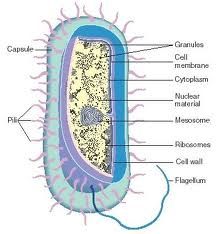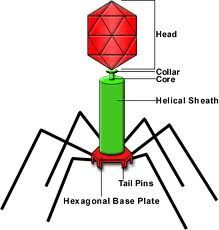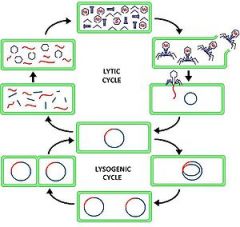![]()
![]()
![]()
Use LEFT and RIGHT arrow keys to navigate between flashcards;
Use UP and DOWN arrow keys to flip the card;
H to show hint;
A reads text to speech;
35 Cards in this Set
- Front
- Back
|
What are the three different shapes of bacteria and the names of each?
|
Rod Shaped- Bacili
Spherical - Cocci Spiral - Spirilla |
|
|
List the composition of a bacterium.
|

(Outside--------> Inside)
-Flagellum -Pili -Outer membrane -Peptidogclan cell wall -Cell membrane -DNA and Ribosomes |
|
|
What are some benefits of bacteria?
|
- Help produce purified water for fertilizer
-Break down dead organisms (decompose) -Produce food and biomass for organisms -Help manufacture lactase ( milk digesting enzyme) -Helps synthesis of Vitamin K (enables blood clotting) |
|
|
What are antibiotics?
|
a medicine that inhibits the growth of or destroys microorganisms.
|
|
|
What do antibiotics do to bacteria?
|
They block the growth and reproduction of bacteria and disrupt proteins or processes that are specific to bacterial cells.
|
|
|
Why are antibiotics ineffective against viruses?
|
Because viruses are non-living and have different components than bacteria. Antibiotics block reproduction so if viruses are non-living then there is nothing for the antibiotics to block.
|
|
|
Why are viruses classified as nonliving?
|
They infect living cells in order to grow and reproduce and take the nutrients and cellular machinery of their host. They cannot reproduce and can sometimes crystalize and living organisms cannot.
|
|
|
What does a typical virus consist of?
|
A core of nucleic acid (DNA or RNA) surrounded by a protein. The virus provides the genetic code of replication, the host provides energy and materials.
|
|
|
Draw and label a bacteriophage.
|

(Top----> Bottom)
-Head -DNA -Tail sheath (body) -Tail Fiber (legs) * Bacteriophage= viruses that infect bacteria. |
|
|
What is the membranous envelope that some viruses have composed of?
|
The viral envelope is protection for capsids that usually come from host membranes. They are composed of lipids.
|
|
|
What is a capsid?
|
A protein coat that gives protection and helps connect to receptor proteins on the host cell.
|
|
|
How does an animal virus enter its host cell?
|
Viruses use capsid to bind to a cells receptor proteins, so the DNA goes into the cell.
OR Lytic or lysogenic cycles. |
|
|
What is the difference between the lytic and lysogenic cycles?
|

Lytic-causes cell to burst quickly
Lysogenic-Cell is not immediately taken over. A key difference between the lytic and lysogenic phage cycles is that in the lytic phage, the viral DNA exists as a separate molecule within the bacterial cell, and replicates separately from the host bacterial DNA. The location of viral DNA in the lysogenic phage cycle is within the host DNA, therefore in both cases the virus/phage replicates using the host DNA machinery, but in the lytic phage cycle, the phage is a free floating separate molecule to the host DNA.The distinction between lysogenic and lytic cycles is that the spread of the viral DNA occurs through the usual prokaryotic reproduction, while the lytic phage is spread through the production of thousands of individual phages capable of surviving and infecting other cells. |
|
|
What is the Lysogenic cycle and how does it work?
|
In the lysogenic cycle, the phage DNA first integrates into the bacterial chromosome to produce the prophage. When the bacterium reproduces, the prophage is also copied and is present in each of the daughter cells. The daughter cells can continue to replicate with the prophage present or the prophage can exit the bacterial chromosome to initiate the lytic cycle.
|
|
|
What is the Lytic cycle and how does it work?
|
The lytic cycle results in the destruction of the infected cell and its membrane.The lytic cycle is a six-stage cycle. In the first stage, called "penetration," the virus injects its own nucleic acids into a host cell. Then the viral acids form a circle in the center of the cell. The cell then mistakenly copies the viral acids instead of its own nucleic acids. Then the viral DNA organize themselves as viruses inside the cell. When the number of viruses inside becomes too much for the cell to hold, the membrane splits and the viruses are free to infect other cells.
|
|
|
What is bacteria?
|
Prokaryotes, unicellular organisms that lack a nucleus.
They cause disease by destroying living cells or by releasing chemicals that upset homeostasis. |
|
|
What is a virus?
|
Is a nonliving particle made of proteins, nucleic acids, and sometimes lipids. They cause disease by directly destroying living cells or by affecting cellular processes in ways that upset homeostasis.
|
|
|
What is the difference between Nonspecific and Specific defenses?
|
> Non-specific-
-Skin -Body secretions: tears, mucus, saliva -2nd line of defense >Specific-uses immune system to determine which cells belong and which do not. -Humoral immunity -Cell-mediated immunity |
|
|
Explain inflammatory response?
|
A response of vascular tissue to harmful stimuli. This includes pain, swelling, heat, redness, and puss.
|
|
|
How does humoral immunity and cell mediated immunity work?
|
>Humoral-Depends on the action of antibodies to tag antigens for destruction.
>Cell-mediated-is an immune response that does not involve antibodies, but rather involves the activation of phagocytes, antigen-specific cytotoxic T-lymphocytes, and the release of various cytokines in response to an antigen. |
|
|
What is a bacteriophage?
|
Bacteriophages are viruses that infect and replicate within bacteria.
|
|
|
What is prophage?
|
Bacteriophage DNA that becomes embedded in the bacterial host's DNA.
|
|
|
What happens after a virus infects a cell?
|
Inside living cells, viruses use their genetic info to make multiple copies of themselves. Some viruses replicate immediately, while others initially persist in an inactive state within the host.
|
|
|
Whats the difference between a virus and a cell?
|
>Virus:
-DNA or RNA in capsid -Reproduction only within a host cell. -Genetic code-DNA or RNA -No growth or development -No use of energy -No response to environment -Change over time >Cell: -Cell membrane, cytoplasm -Independent cell division (sexually or asexually) -Genetic code= DNA -Multicellular (Yes; growth and development) -Use and obtain energy -Respond to environment -Change over time |
|
|
What is binary fusion?
|
When a prokaryote has grown so that is has nearly doubled in size. It replicates its DNA and divides in half, producing two identical cells.
|
|
|
What is endospore?
|
A thick eternal wall that encloses DNA and a portion of the cytoplasm. They can remain dormant for long periods of time and make it possible for some prokaryotes to survive in harsh conditions.
|
|
|
Why are prokaryotes important?
|
Prokaryotes are essential in maintaining every aspect of the ecological balance of the living world. In addition, some species have specific uses in human industry.
|
|
|
What are pathogens?
|
Microorganisms-viruses and prokaryotes-that cause disease.
|
|
|
What is a vaccine and how do they work?
|
Is a preparation of weakened or killed pathogens or inactivated toxins. The vaccine prompts the body to produce immunity to a specific disease.
|
|
|
What are the two types of defense?
|
>Nonspecific-act on a wide range of pathogens.
>Specific-immune system |
|
|
Explain Humoral Immunity
|
-Antibodies can be free floating or on B cells.
-Recognize and attach to antigen -Trigger T cells to stimulate B cells to grow and divide to make more B cells to find antigens -Two types of B cells : Plasma and memory cells |
|
|
What are plasma cells and what are memory cells?
|
>Plasma-Produce and release antibodies that are carried through blood stream to flag antigens to be destroyed. (Temporary)
>Memory-Remember the antigen if it comes to infect again which provides immunity. |
|
|
Explain Cell-Mediated immunity
|
-Macrophages eat antigen and display a portion on the outer surface of its body.
-Signals for T cells which activate B cells, cytoxic T cells, and produce memory T cells. |
|
|
What are cytoxic T cells and Memory T cells?
|
>Cytoxic T cells: Hunt down your body cells that are infected and kill them.
>Memory T cells: work like memory B cells to create long term immunity. |
|
|
What are the two types of immunity and how do they work?
|
>Passive:Occurs when externally produced antibodies are introduced into a persons blood. (From pregnant woman to baby from placenta or breast milk)
>Active:Develops as a result of natural exposure to the antigen or from deliberate exposure to antigen (vaccines). <----- Long term immunity |

